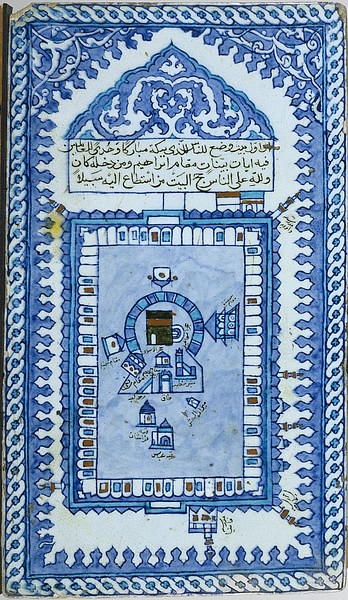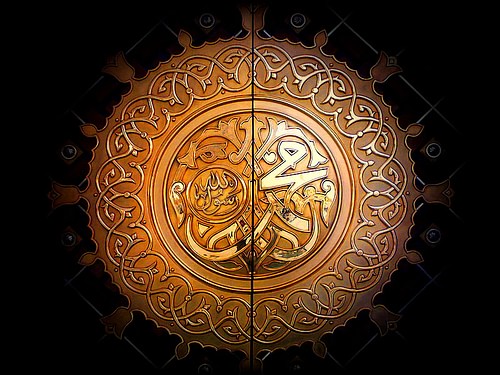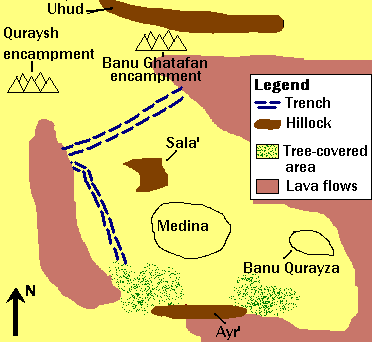
Muhammad ibn Abdullah (l. 570-632 CE) is venerated today as the Prophet of Islam and the “seal of Prophets” by his followers – the Muslims. Muslims believe that Muhammad was the last – hence the “seal” – of many prophets before him in Judaism and Christianity such as Adam, Moses, Abraham, Isaac, Ishmael, Jesus Christ, and others. He was an ordinary person from Mecca, who (according to Islamic tradition) received a divine revelation from God and began preaching a new faith in Arabia (between 610-632 CE). Ultimately these revelations would be compiled in the form of a book, the Quran, after his death.
He was met with stiff resistance from the Meccans, although he did manage to gather a few converts. What started as a feeble group of followers soon turned into an empire when he assumed control of the city of Yathrib (Medina) and began expanding his dominion and his faith through conquest and politics. By the time of his death, Muhammad had managed to unite most of the Arabs under the banner of Islam. This empire would be inherited by his successors – the caliphs of the Islamic world: the Rashidun caliphs (the first four are referred to as Rashidun which means “rightly guided”), the Umayyad Dynasty, Abbasid Dynasty, and later the Ottomans. His empire would spread beyond the borders of Arabia, the faith would also spread at first through conquest and later through trade and missionary work, and his initial revelation would become one of the three great monotheistic religions in the world today.
Early Life
Muhammad was born in 570 CE in the city of Mecca of the Hejaz province of Arabia. His clan – Hashim, belonged to a respected tribe – Quraish, his clan (headed by his grandfather – Abd al Mutalib at the time) provided water to the pilgrims traveling to Mecca. Mecca hosted a variety of idols and was considered a sacred site focused around the Ka'aba (which is still considered sacred by the Muslims).
Muhammad's father, Abdullah, had died while his mother was still pregnant, and his mother, Aminah, also passed away in 576 CE, when he was just 6 years old. His grandfather, Abd al Mutalib, then took the responsibility of raising him, but he also died two years later. Muhammad's uncle, Abu Talib (Abd al Mutalib's son and successor), then devoted his life to raising his nephew, and it is said that they both loved each other just as a father and a son would. As he grew up, he became an honest caravan trader (rare in those days). The Arabs referred to him by the names of “As-Sadiq” (the truthful) and “Al-Amin” (the trustworthy) and, in fact, it is said that many would give their wealth to him for safekeeping, even after he began preaching a faith in which they did not believe.
Marriage with Khadija
When he was 25 years old, a wealthy widow named Khadija (l. 555-620 CE), sent him with one of her trade caravans for business. She was so impressed by his honesty, that she sent him a marriage proposal, which he accepted. Muhammad was bound in matrimony with his first wife (595 CE), a woman who was 15 years older than him but whose support and companionship would help him in his mission; he would not take any other wife while he was married to her, although this was pretty common in Arabia back then. He later commented about his relationship with his wife:
Allah (God) never gave me a better wife than Khadija. She believed in me at a time when other people denied me. She put all her wealth at my service when other people withheld theirs from me. And what's more, Allah gave me children only through Khadija. (Hadith quoted from Musnad Imam Ahmad 6:118)
The Prophet had two sons and four daughters with Khadija (although Shia Muslims only consider one daughter – Fatima – to be born from this marriage); both of his sons died in infancy. Later in his life, Muhammad did marry other women and had another son, who also died in infancy.
Declaration of Prophethood
As he reached his late thirties, he began worshipping in a cave named “Hira”, in the mountain “Jabal al-Nour” (Mountain of Light), near Mecca. It is said that one fateful day, in 610 CE, a light appeared before him and claimed to be the angel Gabriel who approached him with the first revelation from God – “Allah”. It is said that Muhammad was initially perplexed and scared, he ran back home, shivering with fear. It was only after his wife comforted him and took him to her cousin Warqa (a Christian scholar), who recognized and told him that he was a prophet, that he realized the responsibility that had been conferred upon him.
Friction with the Meccans
Muhammad began preaching the oneness of God to his family and close friends; the first convert was his wife Khadija and the first male convert was his close friend Abu Bakr (l. 573-634 CE). It was after some time (in 613 CE) that he began preaching openly, and he met resistance from the Meccans. Mecca hosted many idols at the Ka'aba and their economy was mostly based on pilgrims pouring in from all corners of the Arabian Peninsula to worship these idols, whom Muhammad considered false gods. The Meccans went to all lengths, from bribery to physical torture, to stop him, but he would not give in.
Notwithstanding with Muhammad's growing influence, rival Qurayshite clans boycotted the Hashim clan (616-619 CE) to force them into withdrawing their support for Muhammad, which made conditions for Muhammad and his followers (who are referred to as the “Sahaba” by the Muslims) quite difficult but, in the end, the boycott was lifted. Scholar Tamara Sonn elaborates:
Muhammad and his small community were driven from their homes, forced to live in separate quarters on the outskirts of town, and boycotted. Yet they preserved in their commitment to follow the guidance of God. They were instructed to suffer injustice with dignity. (24)
Muhammad faced continual rejection in Mecca and so turned his attention toward the resort town of Taif in 619 CE. He was initially welcomed there but the people rejected his message and, in the end, he was forced to run from the city as a wild mob of street children threw rocks at him, and he barely made it out of the city alive. According to a famous Muslim legend, the angel Gabriel appeared to Muhammad afterwards, asking for his permission to destroy the town, but Muhammad refused, saying that he was sure that they would convert later on.

His optimism was broken by the death of his uncle Abu Talib and his wife Khadija, in 619 CE (a year remembered as the “Year of Sorrow” by the Muslims). Abu Talib's position was taken by another of Muhammad's uncles – Abu Lahab – who hated him, and lacking any support from his clan, Muhammad was completely vulnerable.
Migration to Medina
Tired of Meccan persecution, some Muslims had already migrated to Abyssinia (Ethiopia) in 615 CE. But for the Prophet and the bulk of his followers, a real opportunity for escaping Meccan oppression came in 621 CE, when some citizens of Yathrib (modern-day Medina) invited the Prophet to their city. Impressed by his message, they wanted the Prophet to act as their ruler. Muhammad and his companions complied and migrated in batches to the city.
Narrowly escaping an attempt on his life, Muhammad left Mecca with his close friend Abu Bakr and, after a perilous journey with the Meccans chasing them, they entered Medina in 622 CE. This migration (hegira) is so important in Islamic history that the Islamic Lunar Calendar considers this as year 0 AH (After Hegira).
With his newly assumed role as the leader of Medina, Muhammad became more than just a preacher; he became a king. Medina would soon be turned into a strong kingdom with standards of justice and unity never before seen in Arabia. Muhammad revised the law code and unified the city, using a mixture of persuasion and force of arms (since betrayal was never forgiven by Arabs who lived by the code of retribution). Scholar Robin Doak elaborates:
During his 10 years in Medina, Muhammad became more than just a spiritual leader. He put his administrative and political skills to good use, effectively acting as the town's leader… Islam was evolving from a religious movement to a powerful political one. (20)
Muhammad also established a new community worship place – “Al-Masjid an-Nabwi” (the mosque of the Prophet). The regular activities of preaching continued but Muhammad now had two distinct advantages over his former life: political power and an army of devoted supporters.
Battle of Badr & Battle of Uhud
From their newfound base, the Muslims wanted to strike back at their former oppressors; they started raiding Meccan trade caravans. As the Meccan economy suffered, their forces united against the Muslims. This culminated in the Battle of Badr (624 CE), where an army of 1,000 Meccans ran before 313 Muslims, who had been led to victory by their king Muhammad (although Muslims saw this as a favor of God).
The Arabs had a strong sense of pride; had the Meccans not struck back after their defeat at Badr, they would have appeared weak and vulnerable to their neighbors – a fatal situation in Arabia. The following year, in 625 CE, another huge army was dispatched from Mecca, under the leadership of Abu Sufyan. He decided not to lay siege to Medina but to draw out the Muslims in open battle.

His forces camped near the Mountain of Uhud, from where they began harassing their foes; this strategy worked and the Muslim army marched out to face the enemy. Though outnumbered again, the Muslims were expecting another victory. Initially, the battle went well for the Muslims; the Meccans deserted the field and fled in panic, leaving behind their camps with all their supplies.
Seeing the enemy flee and victory just moments away, the rearguard deserted its position to collect war booty from the camps (against Muhammad's strict orders). This presented the Meccans with an opportunity, and their cavalry suddenly struck in a surprise attack on the Muslims. Caught off-guard, the Muslims suffered severe casualties; even Muhammad was injured. The Muslims retreated, but the Meccans did not pursue them. They returned to Mecca, declaring victory.
Battle of Trench
Two years later, the Muslims faced an even greater threat: a confederacy. Muhammad had banished two Jewish tribes, Banu Qaynuqa and Banu Nadir; Islamic sources state that they had breached the Treaty of Medina – a treaty of alliance and non-violence formulated by Muhammad when he first assumed the role of king. These tribes, alongside other Jewish tribes from Khaybar (an oasis near Medina, which was a Jewish stronghold in Arabia), and other minor Arabian tribes allied with the Meccans and marched towards Medina, with the intent of a siege. The Muslims prepared for defense by digging a trench around the city to render the confederate cavalry useless; this strategy was unknown to the Arabs and provided the Muslims with a huge tactical advantage. The siege of Medina, also referred to as the Battle of Trench (627 CE), lasted for around 30 days.
The defenders were losing patience as the days went by – and so were the attackers – so the confederates then made a secret alliance with another Medinan Jewish tribe, Banu Qurayza (which was neutral, although still bound by the Treaty of Medina), and the new plan was to attack the Muslims from two fronts. Muhammad was informed of this and sent men to defend that front too. Had the simultaneous attack happened, the Muslims would have been surely defeated, but the Prophet had one last card to play.
Islamic sources report that a respected Arab leader from the confederacy – Nuaym ibn Masud – was secretly a Muslim who was ordered by Muhammad to create divisions between the confederate leaders and Banu Qurayza. The lack of unity, coupled with strong defenses set by the defenders and worsening weather, forced the attackers to retreat; the Muslims had clearly won and with minimal casualties.
The tribe of Banu Qurayza was then brought up on charges of betrayal in violating the peace. Using a verse from the Torah as precedent, a severe sentence was passed by a Muslim judge and approved by Muhammad: all men were killed, women and children alongside, and all property seized. Since then, this event, dubbed as the Massacre of Qurayza, has sparked incessant debate and discussions. What we do know for certain is that had the confederate plot succeeded, the fate of the Muslims would have been no different.
Conquest of Mecca
In 628 CE, when the Muslims wished to go on a pilgrimage (Hajj) to the Ka'aba, they were denied entry by the Meccans who were fearful of their growing power but, instead of conflict, the matter was concluded with the Treaty of Hudaybiyya, which gave the Muslims permission to perform pilgrimage in the following year (which they did – a mini version of it, called umrah) and assured safety for the Meccans as well as the Muslims.
With the matter settled with the Meccans, the Muslims marched towards the Jewish stronghold of Khaybar in 628 CE, whose inhabitants had sided with the Meccans two years earlier. Khaybar was captured by the Muslims, but the locals were allowed to remain in their lands under Muslim control. This trend of keeping local non-Muslims under Muslim overlordship would continue even after Muhammad's death. Non-Muslims, living in Muslim-controlled lands, were considered dhimmi or protected people and had to pay a special tax called the jizya (just as the Muslims paid zakat or alms), although they did enjoy true religious independence. In some cases, they would convert to improve their social status or out of actual devotion, while in other cases, although rarely, forced conversions were also carried out even though Muhammad had clearly instructed his followers against this.

Within two years, the Meccans breached the Treaty of Hudaybiyya when they sided with one Arab tribe (Banu Bakr) against another one (Banu Khuza'a) which was an ally of the Muslims. In 630 CE, the Muslim army approached Mecca; the doors were opened and the city surrendered. Muhammad entered Mecca and offered all people amnesty if they took refuge either in the Ka'aba or Abu Sufyan's house (who had by that time accepted Islam). He then went on to destroy all of the idols in the Ka'aba, officially declaring it as the holy site for Islam. It would be here that he would later on perform his first and last full pilgrimage (or Hajj in 632 CE, before his death; hence it is also known as the farewell pilgrimage in Islamic tradition), and it was also where he announced that the divine revelation – Quran – had been completed.
Death of the Prophet
Another confederacy (of Bedouins) was crushed at the battle of Hunayn (630 CE), and Muhammad had also sent armies to conquer other important regions of Arabia. The city of Taif, from whence he had been forced to flee, submitted to his rule in 631 CE. An attempt to consolidate power over Arab tribes living under Byzantine rule failed with the Muslim defeat at the battle of Mu'tah (629 CE) but it gave Muhammad's successors an idea for their future (successful) endeavors against the Byzantines.

By the time of his death in 632 CE, Muhammad was the most powerful political leader in the whole of Arabia. Most of the tribes had converted to Islam, although most of these conversions had political motivation rather than spiritual. This fact would become quite relevant after Muhammad's death, as these tribes would separate from the Islamic empire and would have to be brought back under control. After a brief illness, Muhammad died peacefully in his own house with his youngest wife, Aisha (Abu Bakr's daughter), by his side.
Conclusion
Muhammad was a man of exceptional vision and administrative talent who also commanded armies in battle with incredible skill and charisma without any prior experience. He endured a great deal of hardship to spread his message, which he must have believed was the truth given to him by God, especially since forsaking his path would have meant rewards beyond his wildest dreams, as the Meccans had promised early on when they were trying to silence him.

As was the norm of his time, Muhammad married multiple women, after the death of his first wife. These marriages were mostly meant to cement tribal alliances, and Muhammad treated his wives with utmost respect and love. Polygamy may seem unsuitable in the modern era, but we cannot object to people living according to the norms of their time. Muhammad, though he had no surviving sons (which was considered necessary for one to be remembered and for which he was severely mocked in his time) has nevertheless not been forgotten. Muhammad's name remains to this day one of the most popular Muslim names worldwide, and his message has reached an unprecedented number of believers.
Although non-Muslims object to the Muslim insistence that Muhammad not be rendered in any image, this is important to Muslims who believe that such images equate with the kind of idolatry Muhammad objected to. Not having a visual image of Muhammad allows one to interpret the Prophet in his or her own way and this allows for a more intimate connection with the founder of the faith. Whenever Muslims in the present day hear, speak, read, or write his name, they add “peace be upon him”, as a sign of respect for all he sacrificed in his life to preach the religion of peace.









